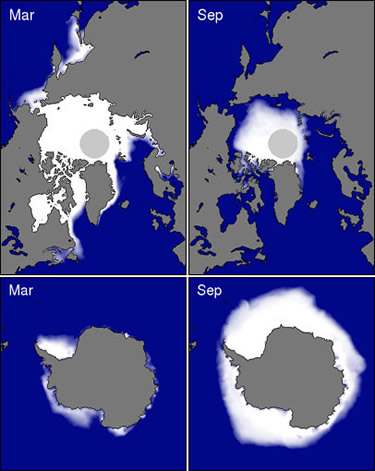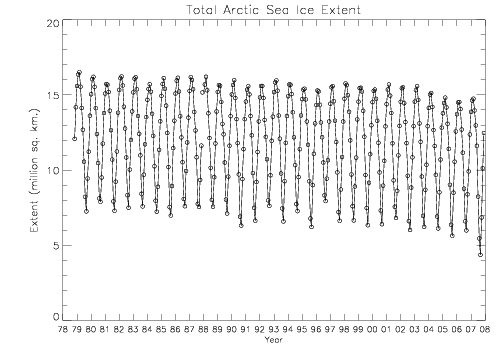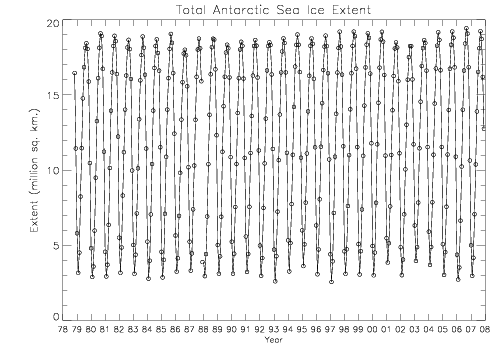L’Artico Scompare. Polo Nord: Addio ai ghiacci.
Tanti allarmi che si ripetono puntualmente ogni estate. Ogni fine estate. Fiumi di inchiostro prezzolato e incosciente. Milioni di dollari ( o euro ) spesi per spaventare il mondo intero sui pericoli del riscaldamento globale.
Nessuno mette in dubbio variazioni sulla temperatura. E nessuno mette in dubbio alcune mutazioni climatiche. Ma prima di strombazzare catastrofi e riportare col copia-incolla, notizie che hanno tutt’altro significato che predizioni di morte imminete, non sarebbe il caso di fare qualche ricerca e mostrare dati ?
Tutti gli studi fatti in diverse parti del mondo, effettuati con criteri rigorosamente scientifici, convergono sempre. A dimostrazione del galileiano metodo scientifico., o meglio metodo sperimentale. Per i cari amici giornalisti del copia-incolla da ANSA, tanto per rinfrescare le idee, o le conoscenze :
Con Galileo Galilei (1564-1642) è stato introdotto il metodo sperimentale: esso si basa su una prima osservazione, seguita da un esperimento, sviluppato in maniera controllata, in modo tale che si possa riprodurre il fenomeno che si vuole studiare. L’esperimento ha lo scopo di convalidare o confutare l’ipotesi che lo scienziato ha formulato, ipotesi che ha lo scopo di spiegare i meccanismi alla base di quel particolare evento.
Nel primo caso (convalida dell’ipotesi) si procede con l’esecuzione di un gran numero di esperimenti, in maniera tale che i risultati acquisiti siano attendibili (analisi statistica): i dati raccolti vengono elaborati e successivamente viene formulata una teoria: quest’ultima viene utilizzata, spesso insieme ad altre teorie, per formulare una legge. La teoria ipotizza la causa o le cause all’origine di un fenomeno mentre la legge descrive un fenomeno che avviene con una certa regolarità.
Nel secondo caso (rigetto dell’ipotesi) l’ipotesi viene modificata e sottoposta a nuovi esperimenti.
Il metodo scientifico si basa su alcuni presupposti, ad esempio che gli eventi naturali osservati hanno delle cause precise ed identificabili, che ci sono degli schemi utilizzabili per descrivere quanto accade in natura, che se un evento si verifica con una certa frequenza alla base c’è la stessa causa, che ciò che una persona percepisce può essere percepita anche da altri, che si applicano le stesse leggi fondamentali della natura, indipendentemente da dove e quando si verificano determinati eventi.
Approfondite voi l’argomento galileiano.
Sul fronte invece della climatologia, vi inviterei a visionare non solo tutti gli studi delle varie univesità sparse nel mondo, ma anche, e qui chiedo scusa a me stesso, ho volutamente fatto un copia incolla, dallo stesso sito del National Snow and Ice Data Center (NSIDC), sulla comparazione tra Artico e Antartico e le misurazioni reali effettuate, sulla consistenza e esistenza dei ghiacci sui nostri poli. A proposito, volevo anche ricordare a qualcuno, che gli Orsi polari vivono in Artico ( vicino al polo nord ) e i pinguini in Antartico ( vicino al polo sud). Nella fretta del copia incolla sono apparsi diversi articoi che affermavano il contrario.
In poche parole, la maggioranza degli studi sperimentali, scientificamente sperimentali, e che dunque arrivano alle stesse conclusioni, dimostrano che le variazioni climatiche e l’innalzamento della temperatura, non solo è determinata in larga maggioranza da fattori ambientali quali gli ENSO ( El Nino
Southern Oscillations) ;che l’Artico non è oggi più caldo di precedenti periodi storici di secoli fa, prima dell’avvento delle centrali a carbone e delle automobili; che, come afferma lo stesso National Snow and Ice Data Center, la variazione negli ultimi dieci anni è stat di circa il 4,1 % in meno….. !
Variazioni quasi insignificanti se rapportati su migliaia di anni, o più. Ma tutti questi studi, vengono sistematicamente ignorati, dall’informazione di massa , preferendo dar spazio a scenari drammatici. Diamo la colpa alle emissioni di ossidi di carbonio ( è vero che sono veleni ), ai gas serra ( è vero che sono dannosi ), a una serie di a volte strampalate ipotesi tipo quella bufala sui peti ( scoregge ) dei dinosauri, causa della loro stessa estinzione.
Ma … senza fare riferimento alcuno ai vari studi, senza fare ricerca alcuna sulle affermazioni catastrofiche e fuorvianti, senza verificare le fonti e confrontarle con altre ugualmente importanti, servendosi solo del copia incolla per fare allarmismo e catastrofismo, non vi viene il dubbio che, più che i ghiacci artici, stiano scomparendo i cervelli , se già non lo hanno fatto, di molti sedicenti informatori giornalistici ?
Ecco un vero copia-incolla.
Arctic vs. Antarctic
Because the Arctic and Antarctic are cold, dark, and remote, we often think these two places are nearly the same. However, they are quite different. One notable difference is that polar bears live only in the Arctic, and penguins live only in the Antarctic. But what about the differences in sea ice between the two regions?
Geography
Sea ice differs between the Arctic and Antarctic, primarily because of their different geography. The Arctic is a semi-enclosed ocean, almost completely surrounded by land. As a result, the sea ice that forms in the Arctic is not as mobile as sea ice in the Antarctic. Although sea ice moves around the Arctic basin, it tends to stay in the cold Arctic waters. Floes are more prone to converge, or bump into each other, and pile up into thick ridges. These converging floes makes Arctic ice thicker. The presence of ridge ice and its longer life cycle leads to ice that stays frozen longer during the summer melt. So some Arctic sea ice remains through the summer and continues to grow the following autumn. Of the 15 million square kilometers (5.8 million square miles) of sea ice that exist during winter, on average, 7 million square kilometers (2.7 million square miles) remain at the end of the summer melt season.
Minimum and maximum sea ice cover for the Arctic and Antarctic. Winter in the Southern Hemisphere is opposite that of the Northern Hemisphere, which explains why Antarctica has less sea ice during February. The black circles in the center of the Northern Hemisphere images are areas lacking data due to limitations in satellite coverage at the North Pole.
—Credit: National Snow and Ice Data Center, University of Colorado, Boulder, Colorado.
The Antarctic is almost a geographic opposite of the Arctic, because Antarctica is a land mass surrounded by an ocean. The open ocean allows the forming sea ice to move more freely, resulting in higher drift speeds. However, Antarctic sea ice forms ridges much less often than sea ice in the Arctic. Also, because there is no land boundary to the north, the sea ice is free to float northward into warmer waters where it eventually melts. As a result, almost all of the sea ice that forms during the Antarctic winter melts during the summer. During the winter, up to 18 million square kilometers (6.9 million square miles) of ocean is covered by sea ice, but by the end of summer, only about 3 million square kilometers (1.1 million square miles) of sea ice remain.
Thickness
Because sea ice does not stay in the Antarctic as long as it does in the Arctic, it does not have the opportunity to grow as thick as sea ice in the Arctic. While thickness varies significantly within both regions, Antarctic ice is typically 1 to 2 meters (3 to 6 feet) thick, while most of the Arctic is covered by sea ice 2 to 3 meters (6 to 9 feet) thick. Some Arctic regions are covered with ice that is 4 to 5 meters (12 to 15 feet) thick.
Patterns of Ice Extent
The above images reveal another notable difference in sea ice. The pattern of Antarctic maximum sea ice is roughly symmetric around the pole, forming a circle around Antarctica. In contrast, the Arctic is asymmetric, with much more ice in some longitudes than others. For example, sea ice off the eastern coast of Canada extends south of Newfoundland to 50 degrees north latitude, and ice off the eastern coast of Russian extends to Bohai Bay, China, at about 38 degrees north latitude. Conversely, in western Europe, the northern coast of Norway at 70 degrees north latitude (2,000 kilometers, or 1,243 miles, farther north than Newfoundland or Japan) generally remains ice-free. Ocean currents and winds explain these differences.
In the Antarctic, the currents and winds tend to flow without interruption around the continent in a west-to-east direction, acting like a barricade to warmer air and water to the north. In contrast, the Arctic region north of the Atlantic Ocean is open to the warmer waters from the south, because of the way the ocean currents flow. These warmer waters can flow into the Arctic and prevent sea ice from forming in the North Atlantic. The waters off the eastern coasts of Canada and Russia are affected by cold air moving off the land from the west. The eastern Canadian coast is also fed by southward-flowing cold water currents that make it easier for sea ice to grow.
Snow Cover over Sea Ice
Because the Arctic Ocean is mostly covered by ice and surrounded by land, precipitation is relatively rare. Snowfall tends to be low, except near the ice edge. Antarctica, however, is entirely surrounded by ocean, so moisture is more readily available. Antarctic sea ice tends to be covered by thicker snow, which may accumulate to the point that the weight of snow pushes the ice below sea level, causing the snow to become flooded by salty ocean waters.
Other Differences
Antarctic sea ice does not reach the South Pole, extending only to about 75 degrees south latitude (in the Ross and Weddell Seas), because of the Antarctic continent. However, Arctic sea ice can extend all the way to the North Pole. Here, the Arctic sea ice receives less solar energy at the surface because the sun’s rays strike at a more oblique angle, compared to lower latitudes.
Water from the Pacific Ocean and several rivers in Russia and Canada provide fresher, less dense water to the Arctic Ocean. So the Arctic Ocean has a layer of cold, fresh water near the surface with warmer, saltier water below. This cold, fresh water layer typically allows more ice growth in the Arctic than the Antarctic.
Variations in Extent
Both Arctic and Antarctic sea ice extent are characterized by fairly large variations from year to year. The monthly average extent can vary by as much as 1 million square kilometers (386,102 square miles) from the year-to-year monthly average. The area covered by Antarctic sea ice has shown a small (not statistically significant) increasing trend.
According to scientific measurements, both the thickness and extent of summer sea ice in the Arctic have shown a dramatic decline over the past thirty years. This is consisistent with observations of a warming Arctic. This trend is a major sign of climate change in the polar regions and may be an indicator of the effects of global warming. (See Trends in the Environment section).
For more information on current sea ice conditions see the Arctic Sea Ice News & Analysis Web page. To read NSIDC press releases on recent Arctic sea ice minima, see the Arctic Sea Ice Press Announcements Archive on the Arctic Sea Ice News & Analysis Web page.
Total Arctic sea ice extent, 1978 to 2007.

—Credit: National Snow and Ice Data Center, University of Colorado, Boulder, CO.
Total Antarctic sea ice extent, 1978 to 2007.

—Credit: National Snow and Ice Data Center, University of Colorado, Boulder, CO.

